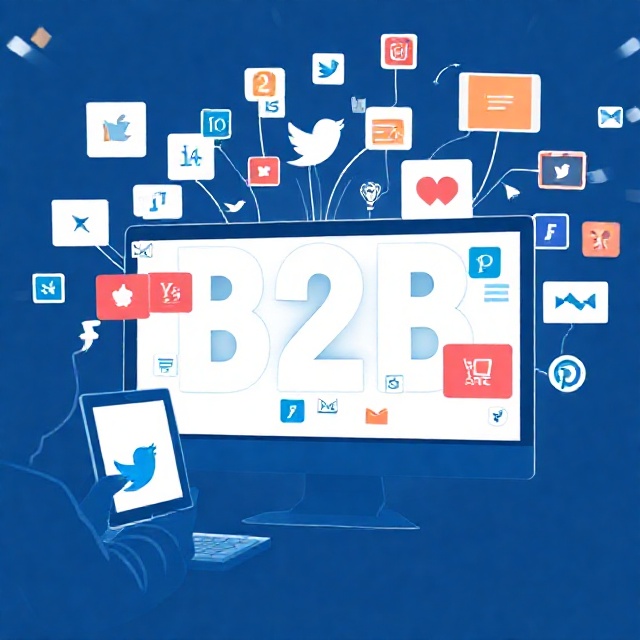Introduction
In today’s cut-throat digital range, social media is no longer a secondary channel for B2B companies; it has become a primary channel for brand awareness, lead generation, and account engagement. However, managing social media on a large scale in a B2B context presents serious challenges for producing a stream of consistent, high-quality content while understanding an extremely complex buyer journey through many touchpoints. Artificial intelligence (AI) seems to be the next great solution, enabling B2B marketers to automate workflows, analyse vastness of datasets, and reach out to specific individuals while ensuring that speed is not compromised. The currently transforming article is about the B2B social media where AI is being integrated, with the mention of functions, capabilities, features, and pitfalls and future possibilities.
Importance of AI in B2B Marketing
Predictive targeting very much influences B2B marketing, augmented by massive content consumption and agile adjustments due to market developments. The potential uplift from generative AI to the global economy is estimated by McKinsey to lie between $2.6 trillion and $4.4 trillion every year, whereby most impacted business functions are marketing and sales. AI helps organizations make deployments in B2B sales more productive, as it automates outreach campaigns while allowing more contextualized involvement with decision-makers.
Social media is in the midst of all this change. Investments are being made by companies in AI-tethered instruments to leverage maximum benefit from it, mostly because the digital advertisement market is expected to cross $800 billion by 2035. Thus, the question is not whether B2B marketers will use AI but how they can maximize the efficiency of its application within social media partnerships.
Key AI Features Reshaping B2B Social Media
1. Content Generation and Automation
Creating timely, tailored content still poses one of the biggest challenges for B2B social media. AI tools can generate text, images, and even video drafts, all in keeping with the brand tone, making it possible to scale output while maintaining consistency. Beyond the creation task, AI scheduling systems identify best posting times for target audiences, significantly improving visibility and engagement. While human oversight will always be important, automation takes repetitive tasks away, allowing marketers to focus on strategic initiatives.
2. Intelligent Audience Targeting and Personalization
Multiple stakeholders are typically involved in B2B buying inertia across functions. AI propels account-based marketing (ABM) to finding decision-makers by analysing firmographic data and forecasting which accounts are likely to convert. Advanced targeting algorithms are also enabling marketers to expand into lookalike audiences so that campaigns will reach just new but pertinent prospects. That kind of precision means much less wasted ad spend and that the correct audience segments will hear your message.
3. Social Listening, Sentiment, and Trend Detection
Through these AI-driven listening platforms, millions of conversations are currently mined across the breadth of LinkedIn, X, Reddit, and several industry forums, forming a holistic view of customer sentiment, competitor activity, and emerging trends. For instance, real-time monitoring would enable a B2B brand to pick early pain points, respond to reported issues quickly, and, in some cases, derive thought leadership opportunities. It notes that these visibility features integrate customer insight directly into content actions for marketers.
4. Performance Insights and Predictive Analytics
Traditional analytics are those that tell what has happened in the past. AI makes this essentially look into the future. Machine learning models develop predictive activity about campaign engagement, potential ROI, and real-time recommendations on adjustments. Predictive attribution also enables marketers to understand the influence of different social touchpoints across the buyer journey so that they can make more accurate allocation of budgets. These insights are proof positive that marketing teams are as much proactive as reactive in the development of their campaigns toward greater efficiency.
Real Application Aspects of AI in B2B Social Media
AI is no more a hypothetical scene. Klarna, for instance, claims $10 million saved per year because the firm incorporated generative AI into the creative production process. Likewise and recently, numerous B2B technology companies are testing AI-enabled content agents that automate nearly 80% of the activities in social media related to posts- from draft to lead nurturing. In the med-tech section, evidence produced from McKinsey (2024) is an example of cases where multichannel content production using generative AIs was scaled without flouting the rules of the industry’s governing standards.
These show that efficiency and effectiveness in the B2B paradigm are realized through strategic embedding of AI in social workflows.
Benefits & Risks: A Balanced View
Benefits
- Scalability: Artificial intelligence automates repetitive tasks, allowing continuous social engagement at scale.
- Efficient Use of Time: Less manual work means more time can be spent on developing value-added strategy.
- Personalization: More accurate scope and application of targeted campaigns at particular accounts or stakeholders.
- Data-Driven Decisions: Forecasting provides better values for monitoring ROI and budget allocations.
Risks
- Accuracy and Hallucination: Vista can create errors or misinterpretations without supervision by humans.
- Authenticity Trepidations: Too much automation may dilute brand voice and trust.
- Data Privacy and Compliance: Regulatory issues surface with collecting and analysing social data.
- Integration Issues: Adoption requires investment in infrastructure, talent, and change management.
Successfully, thus, lies in striking a balance between automation and human creativity and judgment.
Best Practices for Introducing AI in Social Media for B2B
If B2B marketers are considering any AI integration, a well-structured roadmap is a must:
1) Start Small: Trial AI usage on one use case only, such as content scheduling or social listening.
2) Ensure Your Data is of Top Quality: AI models may infer insights only from accurate and clean data.
3) Humans and AI Must Find Harmony: Editorial oversight must remain to keep accuracy and authenticity intact.
4) Choose Tools That are Right for You: Evaluate vendors focusing on transparency, scalability, and ability to integrate.
5) Monitor and Optimize: AI-driven campaigns are subject to testing, measurement, and refinements.
6) Establish Ethical Guardrails: The governance framework that addresses ethical bias, compliance, and responsible use of AI must be embedded.
By following this roadmap, organizations will reduce risk while maximizing benefits of AI within their social channels.
Future Trends: What Comes Next in AI-Driven Social Media?
The next phase in B2B social media AI will increasingly rely on agentic autonomy and multimodality. Newly emergent agentic AI tools can draft campaigns, vary-test, and remotely reach out to leads with scant human input. Meta’s tools are fuelling AI-assisted ad creation, creating novel levels of customizing for vast numbers. AI systems are also increasingly unearth treasures buried deep within those online communities, Reddit and Quora, and mine insights therefrom directly into client social strategy.
For B2B marketers, the imminent horizon would see AI not just as a supporting tool but as one working in synergy with marketers to orchestrate complex, multichannel campaigns.
Conclusion
By creating tools helping organizations streamline content creation, improve targeting, and allow predictive eyes to gaze far ahead, AI is changing the very face of B2B social media. The gains are evident, yet on their pursuit, one must remain cognizant in balancing the road paved towards success promoting authenticity, accuracy, and ethical values. The next generation of marketers will see not AI’s supplanting creativity, but AI working in tandem with the marketer towards tangible business impact. For B2B companies, the time to start thinking in the near future is here.



